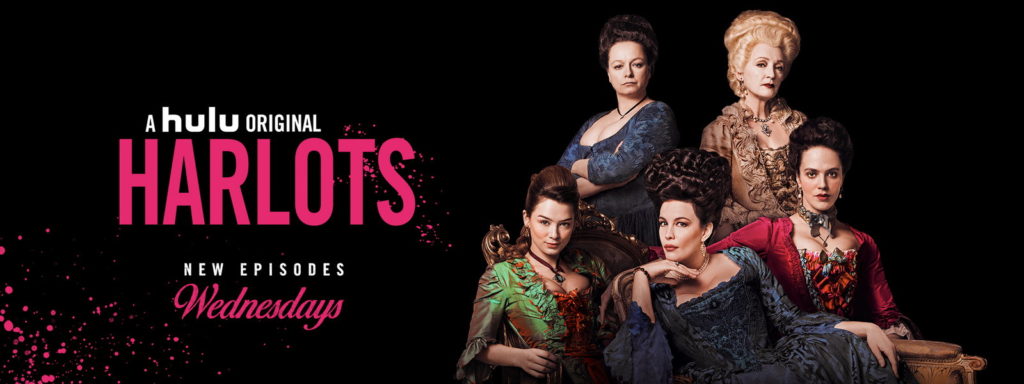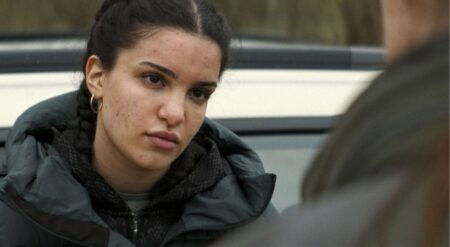
I’ve been awaiting the return of Harlots, a Hulu Original period piece centered around the lives of English harlots and their bawds Wells and Quigley. Written and directed by women, the show was a force to be reckoned with in season one. It presents the viewer with what the team behind the show called a “whore’s eye view” of the story. The power women behind the scenes of the show are matched by how the show explores the varying amounts of privilege each woman in the cast has, even when they are all at the will of the men of the city. Season one was an intersectional lens missed from most period pieces. The stories of the women in the show cross-class, sexuality, and race — the latter of which is often ignored in shows set in the past — and with that explores a variety of feminine experience.
The beginning of season two opens with a bang and shows us the strong women of the show in new circumstances and deals blow that continually keeps the viewers and our cast of characters on edge. Spoilers below the line.
If you’ve read my other Harlots recaps/reviews of season one, you know how much I have loved the portrayal of the interracial Wells family. Margaret and William are a team, and all three children, Lucy, Charlotte, and Jacob, call William Pa without hesitation even though his daughters are not his biological children. But as the episode opens we find the Wells family different from we left them, more strained and distant than before. Lucy is turning tricks like the rest of the girls in the house. Margaret and William fight over his jealousy of Harriett and Will’s bond while Charlotte is in the employ of her mother’s largest rival and the hand of the villain in the show, Lady Lydia Quigley. As Margaret’s girls and husband turning their backs on her because of her guilt and acting out, Violet Cross is caught as a thief and we see a new figure emerge and pull down Quigley’s house around her, Justice Hunt. This episode is about their houses’ falls and it sets up the season beautifully.
Wells House is Broken
When the episode opens we see an angry Margaret. We learn that she suspects Harriett of coveting William, and blames him for believing that he reciprocates. We see an angry Margaret kick Harriett and her two children out, while we see William resent these suspicions and leave the house, seemingly for good. In their anger, both Harriett and William remind Margaret, and the audience of the murder she committed at the end of the last season. In the opening scenes, Margaret seems broken, trying to maintain her facade of strength.
Not only is her family breaking by her husband walking out, but her prized daughter Lucy on her back, her eldest Charlotte is working for her enemy, and even the working girls in her house have begun to leave and at the very least they’re questioning her. “The French one” left, Fanny is now a mother, and Kitty is reluctant to stay with so much turmoil in the house. Having lost the respect of her girls, the refusal to help others from fear of shining a light on her own transgressions seems to, Wells seems to be slipping further and further into loneliness, with those around her still aware of her murder and of her betrayal of Emily Lacey. But as Wells’ house seems to have fallen, there is a ray of hope, Quigley’s is on the way down.
The Fall of Quigley’s House

After an entire season of Wells and Quigley playing cat and mouse, each attempting to bring down the other’s world, we see the new arm of the law in Justice Hunt come into Dame Death’s brothel and ease her into exposing her house of secrets. Taken into custody, tried, and found guilty, Lady Quigley spends the majority of her time this episode in jail. With her bail set at 500 pounds, we follow the fall of her house through the women in her house and life, Charlotte, and Emily Lacey.
When we last saw Charlotte, she was planning to destroy Lady Quigley from the inside. As Quigley is taken away Charlotte takes control of the house, sending the girls where they need to be and immediately attempting to secure her bawd’s bail.
It is through this last action that a new character, Isabelle, played by Liv Tyler, enters the scene. Isabelle is not only gorgeous in her period clothes but intriguing. We don’t know much about her, other than she and her brother have inherited their father’s wealth and she is in debt to Dame Death herself. As Charlotte acts to free her, Margaret and Nancy mobilize to find evidence to convict Quigley as not only a bawd but a kidnapping pimp and murderess.
Last season, Emily Lacey narrowly escaped Quigley’s plot to kill her by sacrificing her to the murderous Spartans after she was handed over to Dame Death by Wells. This season, she is dressed in her finest clothes while drinking and living with George and charging it to Quigley. But using her money doesn’t mean that she isn’t scared of her. As Nancy informs Emily that Quigley has been jailed and asks for her help to see the dame hang, Emily is shaken. This is only alleviated when she begins to ransack and overrun Quigley’s house with her son, drinking her finest port, wearing her clothes and make-up, and partying until her and the girls pass out.
Emily Lacey isn’t the only person with information to take down Quigley, Prince Rassela, was present when she one of Quigley’s men kill the former justice of the city, which we witness in the last moments of season one. As he comes to aid Wells, we see what we assume to be a Spartan, or at the very least a man in Quigley’s employment, threatens Wells, dropping a pig’s heart on her doorstep. This moment however scary comes at the expense of an imprisoned Quigley moving from bawd to harlot once again, performing a sexual favor for the jailer. But this is episode one, and the fall isn’t complete, and the crusade to bring it on ends with a price.
“Justice” is Coming
With the arrival of Justice Hunt, the Harlots landscape of characters is changed and complicated. In a world where morality is second to survival and the women just try to make it to the next day, Hunt is, as Nancy says as “straight as a gunshot.” He is putting the law first, ignoring bribe, and fixing the transgressions of his predecessor. Where the rest of the law find themselves in Quigley’s beds and pocket, Hunt seems like a man who can’t be bought, at least not yet. This is highlighted when Violet Cross is caught stealing a small amount of money a John. He sentences her to be branded a thief (a “T” burned into her hand) and sent to America to live out seven years of servitude, the latter of which is made clear by the dialogue of the character is enslavement and not just a debtor’s life. The show openly highlights that the consequences of breaking the law depend on the woman, taking into consideration class and gender, but also race. It doesn’t seem like anyone will escape his “justice” and solid moral framework, but then again, the Scanwell’s are now preaching forgiveness and speaking up in defense of Violet, so we’ll see where his moral compass turns in the rest of the season.
What can we expect this season?

As we look to the rest of the season with expectations of drama and intrigue, episode 1 highlights that the show is staying on an intersectional course by highlighting the dynamics between Harriett and William, but also William and his daughters. After Willaim leaves Margaret, Lucy goes to find him. After asking for his things, William explains why his connection to Harriett. It is isn’t about love. It’s about understanding. An understanding of what it means to not be free and to be threatened with enslavement. A well-meaning Lucy says that no one is free, and in a moment where some shows would have left it at that, Harlots explains the naivete of assuming all freedom in the 18th century London is equal.
Willaim tells his daughter that she has always been free, “where are your chains” he asks rhetorically. For some feminists, the hardship of being a woman in a patriarchal system is the only thing they can think of, for Harlots, explaining that even the poorest white woman is still free when a Black man and woman face the fear of enslavement highlights the realms of privilege that the characters inhabit. As the season moves along, I’m excited to see the varying positionalities the show-runners explore with the characters. With women in different areas of life being highlighted, the big bad of the show won’t be character development if this episode is any indication.
Beyond character development, episode one begins a set up for the Spartans, a group of abusive rich men who pay Quigley to provide victims for their violent games, to take a more central role in the story. This includes the questioning of Lydia Quigley about murdered women found around London. Although the Spartans are not explicitly mentioned, the description of the victims is equal to what we saw from the men in season one. With Justice Hunt on the case and treating Quigley like any other bawd, it’s clear that the Spartans will come into play and be pressured soon enough. Having threatened the Wells House with a pig’s heart, they were met with a stern and resolved Margaret, unwavering in her pursuit to hang Quigley. But that relentless need to take down Quigley is left shaking as the episode ends with Kitty being placed on their doorstep, throat slit. One of the most prominent harlot in the Wells house, Kitty’s death strikes a blow to their community, their house, and Margaret herself.
Overall, episode one of Harlots season two sets up the season to explore more characters, more dynamics, and ultimately the consequences for every action. Every shot in the show keeps the women at the center of the story and presents every scene from their point of view, showing a world where they’re both the agents but also subjects to the system they live in. I’m excited for the rest of the season.






